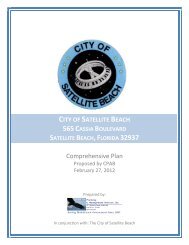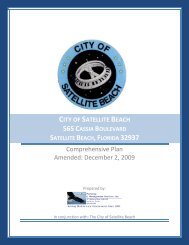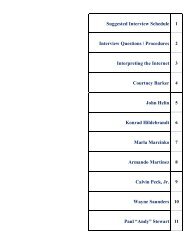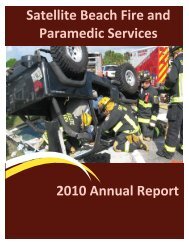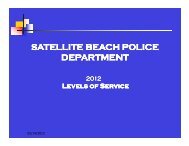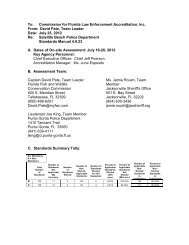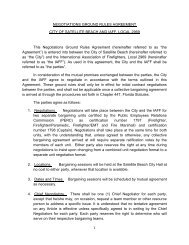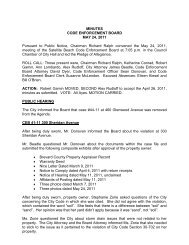Supporting Documents (Data and Analysis) - Satellite Beach
Supporting Documents (Data and Analysis) - Satellite Beach
Supporting Documents (Data and Analysis) - Satellite Beach
You also want an ePaper? Increase the reach of your titles
YUMPU automatically turns print PDFs into web optimized ePapers that Google loves.
on the beach <strong>and</strong> dune system, as well as minimizing hazards to the proposed development during<br />
storm events. The CCCL is a regulatory boundary <strong>and</strong> does not account for the rising sea level.<br />
Rising sea level is accounted for by the thirty-year erosion setback. The first CCCL was established<br />
in 1972, <strong>and</strong> in 1986 the CCCL was relocated along SR A1A, thus implementing the thirty-year<br />
erosion setback. Any proposed development seaward of the CCCL is subject to a site plan review<br />
<strong>and</strong> permit application process by the State, including a requirement that structures be safe from the<br />
advancing shoreline for at least thirty years.<br />
Infrastructure<br />
Additional information related to this subheading, including level of service st<strong>and</strong>ards <strong>and</strong> goals,<br />
objectives <strong>and</strong> policies, are included with the Infrastructure Element in another section of this<br />
Comprehensive Plan.<br />
Stormwater<br />
Prior to development on the barrier isl<strong>and</strong>, stormwater flowed from north to south along swales<br />
between dune ridges which, themselves, were aligned parallel to the coast. During the earliest stages<br />
of development, in the early-1950s, east-west trending channels were dug across the barrier isl<strong>and</strong><br />
from south of Patrick Air Force Base (then the Banana River Naval Air Station) to Indialantic.<br />
Spaced approximately every half mile, they intercepted water which had previously accumulated<br />
during rainstorms <strong>and</strong> flooded the City of Indialantic.<br />
Subsequently, grading for development in the City further reduced the tendency for water to flow<br />
north-to-south. In the older sections of the City of <strong>Satellite</strong> <strong>Beach</strong>, primarily its northern half,<br />
incomplete removal of the dune ridges (most notably underlying Orange, Pineapple, <strong>and</strong> Avocado<br />
Streets) created shallow depressions where flooding has historically been a problem when<br />
undersized, obstructed, or collapsed stormwater drains could not remove water as fast as it<br />
accumulated. Currently, stormwater flows west <strong>and</strong> empties into finger canals <strong>and</strong> thence into the<br />
Gr<strong>and</strong> Canal <strong>and</strong>, finally, the Banana River. The exception to this is several drainage outfalls along<br />
SR A1A which direct stormwater to the ocean. Those located within the City <strong>and</strong> under the<br />
responsibility of the DOT are located at Grant Avenue <strong>and</strong> a location midway between Cinnamon<br />
Drive <strong>and</strong> Norwood Avenue. In both locations the outfall causes significant beach erosion. An<br />
inactive outfall under the City's jurisdiction is located at Palmetto Avenue. Direct discharge of<br />
stormwater into the ocean is not permitted under current regulations; however, since these features<br />
predated the law, they have been permitted to remain in place.<br />
<strong>Satellite</strong> <strong>Beach</strong> has incorporated regulations set forth by the Florida Department of Environmental<br />
Protection (DEP) <strong>and</strong> the St. Johns River Water Management District (SJRWMD) into the City Code<br />
for guidance in the planning of drainage structures. Drainage plans for all new developments must<br />
show the sizes <strong>and</strong> types of all drainage structures from the proposed development to the outfall. An<br />
impact assessment of each drainage plan on the existing city drainage system <strong>and</strong> the surrounding<br />
area is also required based on an assumed rainfall for a five-year storm design as defined in the 1978<br />
edition of the Florida Department of Transportation Drainage Design Manual.<br />
Coastal Management/Conservation Element<br />
<strong>Data</strong> <strong>and</strong> <strong>Analysis</strong> 5-7



